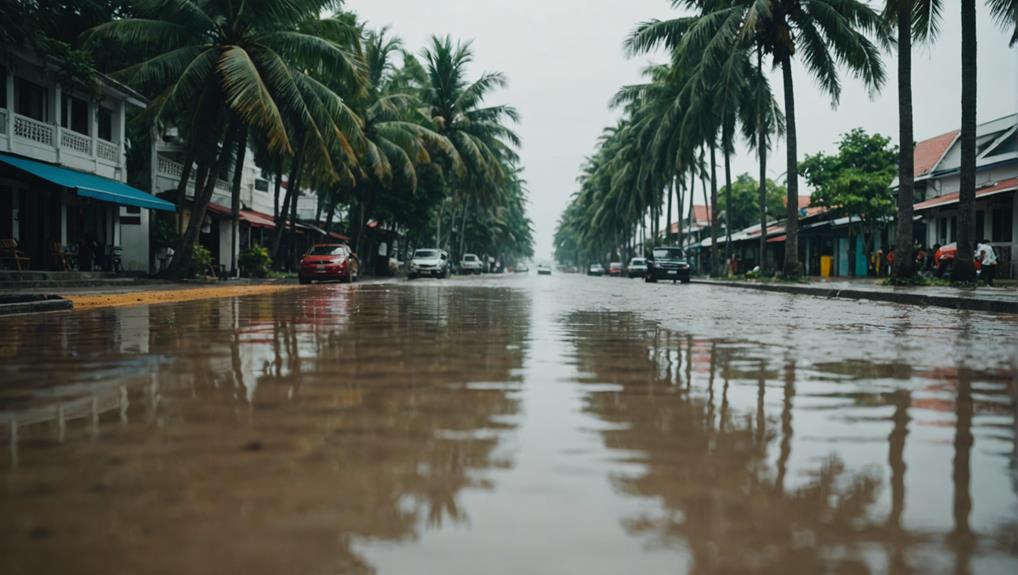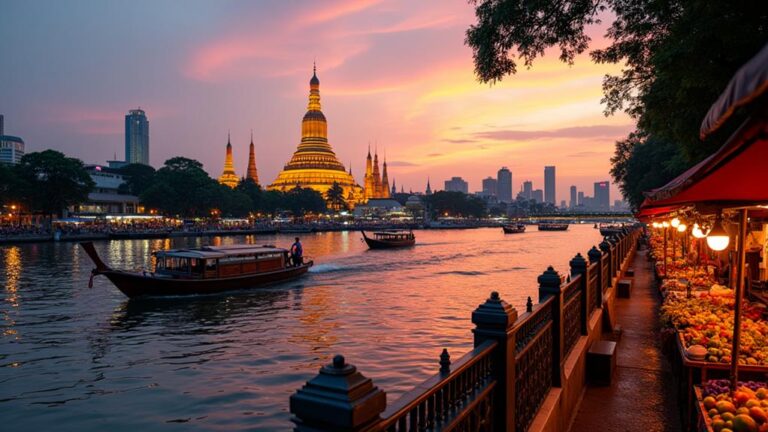You’ve always dreamed of exploring Thailand’s stunning temples, bustling markets, and idyllic beaches, but you’ve also heard whispers of sweltering heat and torrential rains. While Thailand’s tropical climate can be a blessing, it can also be a curse – especially during the wrong months. As you start planning your trip, you’ll want to know which months to avoid, lest you find yourself sweating profusely or dodging raindrops. But don’t let the weather forecast dictate your travel plans just yet – there are ways to navigate Thailand’s climate and still have an unforgettable adventure.
Table of Contents
Key Takeaways
- Avoid April in Central Thailand due to scorching heat, humidity, and heavy downpours.
- Skip May to October in Southern Thailand due to peak rainy season, heavy rainfall, and flooding.
- Steer clear of July to October in Northern Thailand due to the rainiest months, heavy rainfall, and travel disruptions.
- Avoid May in Eastern Thailand due to extremely high temperatures and humidity throughout the year.
- Skip March to May, the peak hot season, when temperatures can soar up to 40°C, making outdoor activities difficult.
Worst Months in Central Thailand
You’ll want to steer clear of Central Thailand during April, when the scorching heat index regularly reaches 104°F (40°C) and the air is thick with humidity.
This is probably the worst time to visit Central Thailand, with the weather being unbearable for most tourists. The heat is oppressive, making it difficult to explore the region’s famous temples, markets, and museums.
To make matters worse, April marks the beginning of the rainy season in Central Thailand, which means you can expect frequent, heavy downpours that can disrupt your travel plans.
The rainy season in Central Thailand typically lasts from April to October, but the worst of the bad weather usually occurs during the initial months.
If you can, try to avoid visiting Central Thailand during this month, as the rain and heat can make your trip uncomfortable and frustrating.
Peak Rainy Season in South
The southern regions of Thailand, particularly the provinces of Surat Thani and Krabi, experience the peak rainy season from May to October, with torrential downpours and flash flooding becoming a regular occurrence.
As you plan your trip to Thailand, it’s essential to be aware of these months, which are considered the wettest in the south.
September is usually the wettest month, with heavy rainfall and strong winds making outdoor activities challenging.
The peak rainy season in the south coincides with the Monsoon season, which brings bad weather and makes it one of the months to avoid.
You’ll want to skip these months if you’re looking forward to enjoying Thailand’s beautiful beaches, islands, and outdoor attractions.
The rain can be relentless, and the flooding can be severe, making it difficult to get around.
If you’re planning to visit southern Thailand, consider avoiding the peak rainy season and instead opt for the drier months between November and April.
Avoiding the Monsoon Season
When planning your trip to Thailand, avoiding the monsoon season, which typically runs from May to October, can make all the difference in ensuring a smooth and enjoyable journey.
You’ll want to steer clear of Thailand’s rainy season, which often brings heavy downpours, flooding, and disruptions to your travel plans.
The monsoon season in Thailand is characterized by frequent and intense rainfall, making it challenging to explore the country’s outdoor attractions.
If you’re looking to avoid the rainy season, consider visiting between November and February, when the weather is generally dry and pleasant.
These months offer ideal conditions for exploring Thailand’s temples, beaches, and cities.
The hottest months, typically April and May, can be challenging, but the temperatures can be managed with some planning.
The period from July to October is usually the hottest month in Thailand and the peak of the monsoon season, so it’s best to avoid it altogether.
Rainiest Months in Northern Thailand
As you plan your trip to Northern Thailand, you’ll want to steer clear of the rainiest months, which typically fall between July and October.
During this time, heavy rainfall can cause flooding, like the notorious Chiang Mai floods, and disrupt your travel plans.
Ahead, you’ll find out which months to avoid and why the monsoon season can be a major dampener on your trip.
Chiang Mai Floods
Flooding in Chiang Mai typically peaks during the rainiest months of August to October, so you’ll want to plan your visit around these soggy seasons to avoid getting soaked.
This is the time when the northern regions of Thailand receive nonstop rain, causing floods and disruptions to daily life.
It’s not the ideal time to visit Thailand, especially if you’re looking forward to exploring Chiang Mai’s beautiful temples and bustling markets.
The heavy pollution and continuous rain make it difficult to enjoy the city’s attractions.
Additionally, the planting season usually coincides with the rainy season, which means you mightn’t get to experience the best of Chiang Mai’s natural beauty.
If you’re planning to visit Chiang Mai, consider the dry season, which typically runs from November to February.
This is the best time to visit Thailand, with clear skies, comfortable temperatures, and minimal rain.
You’ll be able to explore the city’s hidden gems without worrying about floods and heavy pollution.
Heavy Rainfall Season
Your travel plans to northern Thailand will likely be affected by the heavy rainfall season, which brings relentless downpours to the region from August to October.
During this time, the rain can be so intense that it’s wise to avoid traveling to the area altogether. The heavy rainfall makes outdoor activities a real challenge, and flooding is a common issue.
If you’re looking for the best time to visit northern Thailand, it’s best to skip these months.
The weather in Thailand can be quite unpredictable, but one thing’s for sure – the heavy rainfall season isn’t ideal for traveling.
The rain can cause disruptions to transportation, and tourist attractions might be closed due to bad weather.
If you’re planning a trip to northern Thailand, it’s best to plan around the heavy rainfall season. The high season, which typically starts in November, is a better time to visit.
You’ll get to enjoy the region’s beauty without the hassle of heavy rainfall. So, if you want to make the most of your trip, avoid traveling to northern Thailand from August to October.
Monsoon Months Ahead
Head straight into the heart of northern Thailand’s monsoon season, which pours its full fury from September to November, bringing with it the most torrential rainfall of the year.
You might want to avoid Thailand during these monsoon months, as the bad weather can put a damper on your travel plans. The heavy rainfall makes it challenging to get around, and the hot weather only adds to the discomfort.
If you’re looking for the best weather, you’re better off visiting during the cooler months from December to February. These months offer a more pleasant climate, making it an ideal time of year to explore northern Thailand.
However, if you’re planning to visit during the monsoon season, be prepared for delays and disruptions. The rainfall can be intense, and it’s essential to plan ahead and stay informed about weather updates.
If you can, try to skip these monsoon months and opt for a more comfortable and enjoyable trip to Thailand.
Disruptive Weather in Eastern Thailand
During May, you can expect the eastern region of Thailand, including Rayong and Pattaya, to swelter under the hottest temperatures of the year, with the mercury often soaring to a scorching 96.26°F (35.7°C).
The eastern region’s weather is characterized by high temperatures and humidity throughout the year, making it essential to plan accordingly.
May marks the beginning of the rainy season, which lasts until October, with September being the wettest month, receiving an average of 13.6 inches (345 mm) of rainfall.
The region’s terrain, being mostly flat and low-lying, makes it vulnerable to flooding during the rainy season.
With an average relative humidity of 79% in September, it’s the most humid month, making outdoor activities challenging.
To avoid disruptions, it’s vital to stay informed about weather conditions and plan your activities accordingly.
Be prepared for unpredictable weather patterns and high humidity levels throughout the year in eastern Thailand.
Unfavorable Travel Conditions
The sweltering heat and humidity in eastern Thailand can make traveling a real challenge, especially if you’re not prepared for the extreme weather conditions.
You’ll want to avoid visiting during the peak hot season, which typically occurs from March to May, when temperatures can soar up to 40 degrees Celsius. This time of year, the heat and humidity can be unbearable, making it difficult to enjoy outdoor activities.
If you’re planning to visit Thailand, it’s essential to choose the right time of year.
The best time to travel is during the cool season, from November to February, when the weather is more pleasant and rainfall is minimal. This is considered the best month to visit Thailand, with temperatures ranging from 20 to 25 degrees Celsius.
During this time, you’ll be able to enjoy outdoor activities like exploring temples, trekking, and visiting beaches without the discomfort of extreme heat. By choosing the right time to travel, you’ll be able to make the most of your trip and avoid unfavorable travel conditions.
Frequently Asked Questions
What Month Should I Avoid Thailand?
You should avoid Thailand in March and April when crowded streets, tourist scams, high prices, overbooked flights, long queues, sweltering heat, rowdy parties, and packed beaches make your trip a chaotic, exhausting experience.
What Months Does Thailand Have Bad Weather?
As you step into Thailand’s tropical landscape, imagine sweltering heat waves, summer storms, and foggy mornings. You’ll experience unpredictable weather patterns, exacerbated by climate change, with intense rainfall records during monsoon seasons, punctuated by dry spells.
What Month Is Typhoon Season in Thailand?
You’re heading to Thailand, but when is typhoon season? Typically, it’s from May to October, with peak storms in August and September. Be prepared for typhoon patterns, storm surges, and cyclone risks, and stay alert for weather alerts and flood dangers.
What Are the Least Rainy Months in Thailand?
You’ll love Thailand’s dry season, from December to April, with minimal rainfall and sunny skies, making it the best climate for tourists, with comfortable humidity levels, perfect for exploring without worrying about the monsoon season’s weather forecast.











